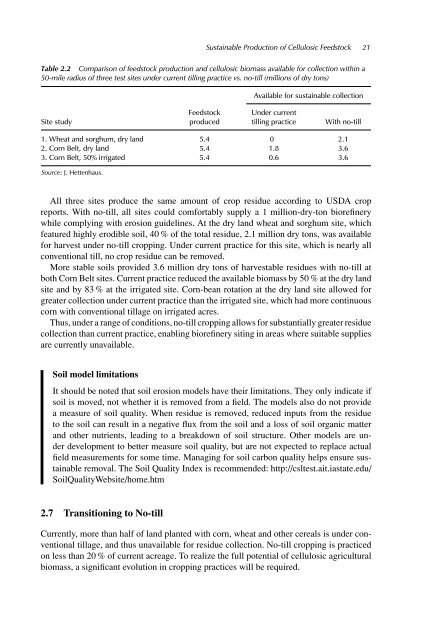Biofuels in Perspective
Biofuels in Perspective
Biofuels in Perspective
You also want an ePaper? Increase the reach of your titles
YUMPU automatically turns print PDFs into web optimized ePapers that Google loves.
Susta<strong>in</strong>able Production of Cellulosic Feedstock 21<br />
Table 2.2 Comparison of feedstock production and cellulosic biomass available for collection with<strong>in</strong> a<br />
50-mile radius of three test sites under current till<strong>in</strong>g practice vs. no-till (millions of dry tons)<br />
Site study<br />
Feedstock<br />
produced<br />
Available for susta<strong>in</strong>able collection<br />
Under current<br />
till<strong>in</strong>g practice With no-till<br />
1. Wheat and sorghum, dry land 5.4 0 2.1<br />
2. Corn Belt, dry land 5.4 1.8 3.6<br />
3. Corn Belt, 50% irrigated 5.4 0.6 3.6<br />
Source: J. Hettenhaus.<br />
All three sites produce the same amount of crop residue accord<strong>in</strong>g to USDA crop<br />
reports. With no-till, all sites could comfortably supply a 1 million-dry-ton bioref<strong>in</strong>ery<br />
while comply<strong>in</strong>g with erosion guidel<strong>in</strong>es. At the dry land wheat and sorghum site, which<br />
featured highly erodible soil, 40 % of the total residue, 2.1 million dry tons, was available<br />
for harvest under no-till cropp<strong>in</strong>g. Under current practice for this site, which is nearly all<br />
conventional till, no crop residue can be removed.<br />
More stable soils provided 3.6 million dry tons of harvestable residues with no-till at<br />
both Corn Belt sites. Current practice reduced the available biomass by 50 % at the dry land<br />
site and by 83 % at the irrigated site. Corn-bean rotation at the dry land site allowed for<br />
greater collection under current practice than the irrigated site, which had more cont<strong>in</strong>uous<br />
corn with conventional tillage on irrigated acres.<br />
Thus, under a range of conditions, no-till cropp<strong>in</strong>g allows for substantially greater residue<br />
collection than current practice, enabl<strong>in</strong>g bioref<strong>in</strong>ery sit<strong>in</strong>g <strong>in</strong> areas where suitable supplies<br />
are currently unavailable.<br />
Soil model limitations<br />
It should be noted that soil erosion models have their limitations. They only <strong>in</strong>dicate if<br />
soil is moved, not whether it is removed from a field. The models also do not provide<br />
a measure of soil quality. When residue is removed, reduced <strong>in</strong>puts from the residue<br />
to the soil can result <strong>in</strong> a negative flux from the soil and a loss of soil organic matter<br />
and other nutrients, lead<strong>in</strong>g to a breakdown of soil structure. Other models are under<br />
development to better measure soil quality, but are not expected to replace actual<br />
field measurements for some time. Manag<strong>in</strong>g for soil carbon quality helps ensure susta<strong>in</strong>able<br />
removal. The Soil Quality Index is recommended: http://csltest.ait.iastate.edu/<br />
SoilQualityWebsite/home.htm<br />
2.7 Transition<strong>in</strong>g to No-till<br />
Currently, more than half of land planted with corn, wheat and other cereals is under conventional<br />
tillage, and thus unavailable for residue collection. No-till cropp<strong>in</strong>g is practiced<br />
on less than 20 % of current acreage. To realize the full potential of cellulosic agricultural<br />
biomass, a significant evolution <strong>in</strong> cropp<strong>in</strong>g practices will be required.








